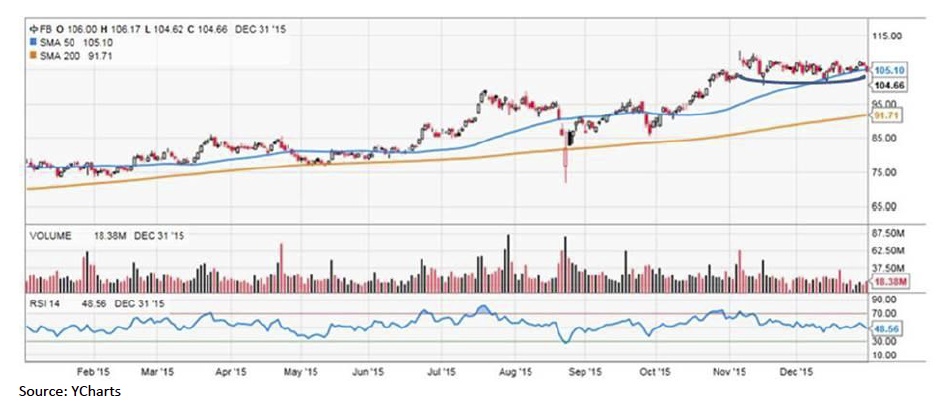The same can be said about some individual stocks; Facebook (FB/$104.66/Outperform) is an example. Facebook has effectively gone sideways since its peak in early November. The “bears” look at the chart and see a broadening top. The “bulls” see a consolidation and think FB is getting ready to breakout to the upside (chart 3). I had lunch with my friend Tom O’Halloran recently. Tom is the portfolio manager for Lord Abbett’s “Growth Leaders Fund” (LGLAX/$22.49), a fund that I own. Tom turned me on to FB when it was in the $20s, suggesting that per click advertising fees they were getting from businesses was going to increase dramatically. Raymond James’ fundamental analysts agree, and on November 4, wrote:
“Facebook reported a strong 3Q marked by 57% y/y forex neutral ad revenue growth, 72% y/y mobile revenue growth, and solid engagement trends (daily average user growth of 17% y/y). Facebook also noted strength from newer ad formats and platforms, including carousel ads, dynamic product ads, videos, and Instagram. We reiterate our Outperform rating and increase our price target … as we expect: 1) continued strength in user growth across platforms; 2) increasing advertiser demand and ad relevance to drive pricing; 3) increasing monetization from newer platforms (i.e., Instagram).”

So last week began with a whimper on Monday (-24 Dow points), we had a BANG on Tuesday (+192 points), gave some of it back on Wednesday (-117), and then Thursday erased everything (-178). For the week, the D-J Industrials (INDU/17425.03) surrendered 0.72%, leaving it down 2.2% for 2015. The S&P 500 (SPX/2043.95) did a little worse, shedding 0.83%, capping a year to date loss of 0.7%. However, when dividends are included, the SPX was up 1.4% on the year. In fact, ALL of the indices we monitor were down for the holiday shortened week. The best performing indexes for 2015 were the NASDAQ Composite (+5.73%) and the NASDAQ 100 (+8.3%). The worse performing index for the year was the D-J Transportation Average (TRAN/7508.710), which fell 17.85%. The action of the Transports has been diverging from the Industrials since late last year. Said action elicited this prose form the Birmingham, AL based The Collier Group’s investment analyst Mick St. Amour:
“Many market participants [are] asking themselves is the market about to rollover or was 2015 more of consolidation year for equities? You see, when you look at the most recent action of the Dow Jones Industrials versus the Dow Transports, a bull will tell you that we have a downside non confirmation with the transports, while a bear will say that we have an upside non confirmation with the Dow. No wonder so many folks are coming into 2016 confused because there are market indicators that are giving us conflicting signals. But, if I had to make a call on fundamentals alone, I suspect that 2016 will be a lot like 2015 in some ways and different in others.”
The call for this week: Obviously, my call for a “rip your face off rally” from the December low of ~1994 for the SPX was a bad “call.” In fact, the typical “Santa Rally” didn’t show up either, but parsing the data shows that doesn’t necessarily mean bad stock market performance in 2016. Indeed, according the insightful folks at Ned Davis research, “Of the 35 bear markets (since 1900); only 12 of them have occurred following failed ‘Santa Clause’ rallies.” Ladies and gentlemen, that’s a success factor of only 34%. Nevertheless, Santa failed to call in 2015, making my call for a year-end rally just plain wrong.
In this business, when you are wrong, you say you are wrong and move on. Manifestly, if you take a stand, and make a call, you are going to be wrong at best about one-third of the time, yet most pundits never admit they have made a bad call. And that bad call is extending this morning with the preopening S&P 500 futures off another 30 points on renewed Chinese growth fears, as China’s stock market slumped 7% overnight and trading was suspended. The action suggests yet another downside test of the S&P’s 1990 to 2000 support zone.
Jeffrey Saut is chief investment strategist at Raymond James.








